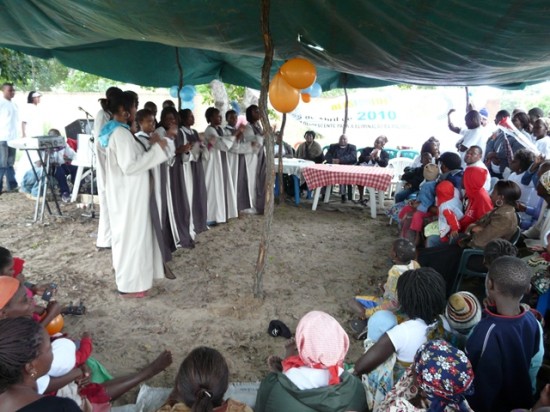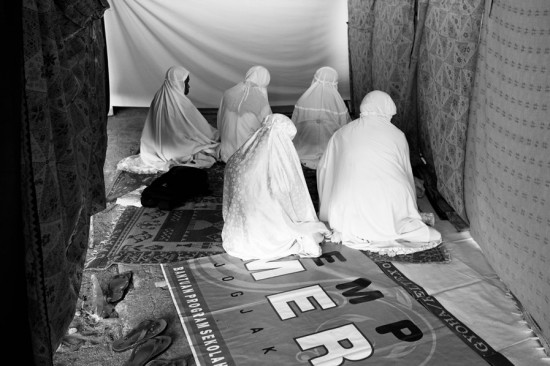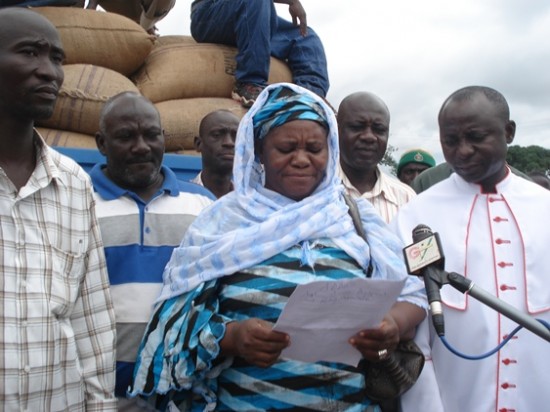 Local Faith Communities such as this one at a Malaria awareness raising event in Maputo, Mozambique, are providing humanitarian assistance to those in need. Photo courtesy of Jean Duff on behalf of PIRCOM.
Local Faith Communities such as this one at a Malaria awareness raising event in Maputo, Mozambique, are providing humanitarian assistance to those in need. Photo courtesy of Jean Duff on behalf of PIRCOM.Our work has been motivated by the growing awareness of the role of religion in global affairs in the past two decades, with more and more agencies recognising that religion cannot simply be overlooked. Currently, however, many humanitarian actors are uncomfortable or unfamiliar with the language, structures and operations of local faith communities (LFCs). So we set out to find what evidence and experience can inform agencies trying to better understand local religious dynamics and build productive partnerships with local communities of faith.
 A temporary mosque in the Stadion Maguwoharjo IDP camp, Yogyakarta, Indonesia. Photo courtesy of Lindsay Stark
A temporary mosque in the Stadion Maguwoharjo IDP camp, Yogyakarta, Indonesia. Photo courtesy of Lindsay StarkLFCs certainly provide valuable support for those affected by conflict, displacement and other emergencies. They are often equipped with valuable resources – buildings for shelter and protection – and social capital – volunteers, staff and access to wider networks – that form the physical basis for faith communities’ response to emergencies. The fact that LFCs are already present prior to, during and after an emergency provides them with a uniquely immediate opportunity to deliver support in the first 24 hours after an emergency; it has been this recognition that has given major impetus to agencies’ attempts to partner with LFCs.
The ‘embeddedness’ of LFCs often endows them with a better understanding of local dynamics than international agencies, enabling them to ensure that assistance is culturally appropriate. In one case we came across, Muslim women in the aftermath of the 2004 tsunami considered headscarves to be a ‘basic need’ that must be included in emergency services, since they were usually wearing their indoor clothing when the tsunami hit. This factor had been initially overlooked by the UN agency providing assistance. Such local understanding and authority can have particular value for the pursuit of transitional and durable solutions in response to conflict, with religious communities being particularly well placed to engage with controversial and localised issues.
We have also found good reason to view the resources of faith for affected populations as not solely physical. With growing recognition that the psychosocial well-being of people must be considered together with their physical wellness, the place of faith as a source of hope, support and strength to cope has been increasingly explored by academics and practitioners. We have found that many academic studies conclude that there is a positive correlation between certain intrinsic religious beliefs – that God is on your side, that hardship can be a test from God, that a positive attitude will lead to a positive outcome, etc. – and the ability to cope with and recover from suffering.
Beyond intrinsic beliefs, too, religious practices have also been found to operate in support of resilience: prayer may help a child to therapeutically tell the story of their experience of war or disaster; counselling is often among the primary pastoral duties of religious leaders within their communities; and religious narratives that re-tell received stories may serve to solidify community identity and ultimately build resilience.
Others argue that faith can constrain resilience through a lack of professional training and preparation, having vested local interests, and promoting values that can lead to fatalism and inaction. It has not been uncommon to find religious narratives of conflict and disaster that refer to divine retribution for sin – such narratives arguably foster hopelessness and create obstacles to the attempt to solve protracted social and environmental problems.
 Anglican priest of the Diocese of Tamale, Ghana, with local government responding to floods with food aid 2012. Photo courtesy of Anglican Alliance
Anglican priest of the Diocese of Tamale, Ghana, with local government responding to floods with food aid 2012. Photo courtesy of Anglican AllianceHowever, even this commonly held criticism of religious communities has been challenged during the course of our work. One member of our collaboration encouraged us to see that the concept of human responsibility for disaster that roots the ‘divine retribution’ explanation can actually spur action in communities to prepare for – and mitigate – future events. The ambivalence of this example – i.e. retribution narratives could operate in support and/or hindrance of resilience – has been a common conclusion for us to draw regarding the correlation between religion and resilience. In the same way, the ‘embeddedness’ of leaders of religious communities can be an asset, but partnering with religious communities can risk bolstering power dynamics within communities that may be corrupt, undemocratic or overly biased toward their own community.
This pattern has emerged throughout our work, raising the question of the treatment of religion or religions as homogenous units. Instead of finding that ‘religion’ - or even particular religions – are ‘good’ or ‘bad’ for specific development outcomes such as resilience, it has become clear that religions are complex and powerful phenomena, often at the centre of societies, that have the potential to support or obstruct the pursuit of such outcomes.
Our study – the scoping phase of a larger research programme investigating religion’s role in modern humanitarianism – has been motivated by the increasingly felt need to formulate policy on religion in world affairs. The continuing presence and public nature of religion in almost every part of the world demands that we carefully consider the promises and risks of engagement with this double-edged sword. It is our hope that the research we continue to do will open the door for humanitarian and peace-building agencies to maximise the positive outcomes of engagement with local faith communities.
This article is based on a larger scoping study.







